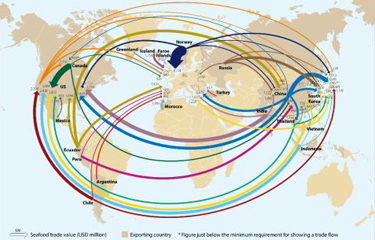The past year has seen major upheavals in seafood trade caused by the falllout from Russia's invasion of Ukraine, pandemic-related supply-chain shifts, and the cancellation of fishing seasons due to environmental issues. Nonetheless, many companies and fisheries experienced banner years, and there are predictions that 2023 will be just as good – if not better.
SeafoodSource has identified the top 5 most-read supply and trade stories of 2022, which reflect some of the year’s major events.
Number 5: BC salmon fishery on verge of commercial collapse
Low returns, a lack of commercial infrastructure, and failures by Canada’s Department of Fisheries and Oceans have all combined to put the salmon fishery in British Columbia, Canada, near to commercial collapse.
In recent years, climate change, extreme weather events, and fishery management issues led to the fishery losing Marine Stewardship Council certification, and stakeholders told SeafoodSource they fear the industry may have reached a breaking point. Aside from commercial sockeye fisheries on the North and Somass rivers, little of the industry remains, according to Watershed Watch Consultant and Fisheries Advisor Greg Taylor.
“Besides those sockeye fisheries in the North and the Somass, there is essentially no commercial fishing,” he said. “I think you can talk about the collapse of commercial fisheries, but I would shy away from using the term for salmon themselves. Salmon populations are low, but they’re still there.”
Number 4: As Copper River salmon season opens, Alaska gears up for big runs in 2022
The salmon-fishing season in the U.S. state of Alaska officially began on Monday, 16 May, 2022 – and the industry was anticipating a banner year.
Demand for salmon was high, and Copper River salmon was fetching huge prices: a whole king salmon was selling for USD 900 (then EUR 853) and fillets at USD 130 (then EUR 123) per pound, and a whole sockeye was going for USD 200 (then EUR 190) and fillets at USD 75 (then EUR 71) per pound at Seattle’s Pike Place Market, The Cordova Times reported.
The positive initial predictions proved mostly true, and the Bristol Bay sockeye run hit a massive all-time record of 76 million fish.
Number 3: Difficult future ahead for Alaska’s crab industry
Alaska’s crab fishery became the subject of big media attention following the complete closure of the snow crab, red king crab, and blue king crab seasons for 2022 and 2023.
Now, the fishery is facing a difficult future and Alaska’s two U.S. senators, Lisa Murkowski and Dan Sullivan; and Washington’s two senators, Patty Murry and Maria Cantwell; sent a letter to U.S. Commerce Secretary Gina Raimondo asking her to declare a federal fishery disaster for the 2022-2023 Bering Sea snow crab, the 2022-2023 Bristol Bay red king crab, and the 2021-2022 Bristol Bay red king crab seasons. The cited an estimate from Alaska’s state government putting losses from the closures at USD 287.7 million (EUR 270.7 million).
A huge crash in crab populations forced regulators to close Alaska’s crab-fishing seasons, and scientists estimate that for species like opilio, the population won’t recover for at least another four years. Multiple factors combined to contribute to the crash, including a lack of surveys in 2020 due to Covid-19.
Number 2: Pacific Seafood’s Dan Obradovich discusses U.S. crab market crisis
Clackamas, Oregon, U.S.A.-based Pacific Seafood's director of business development and the Dungeness crab category manager, Dan Obradovich, shared his insight on the state of the U.S. crab market amid closed seasons and price crashes.
Obradovich told SeafoodSource in November that there’s been a “complete reversal” of product coming into the market and an “undoing of demand for crab.” The massive decreases in supply, he said, were offset by similar decreases in demand.
Despite the challenges, Obradovich retained a hopeful outlook for the future of the industry, which he said was based on his decades of experience.
“It’ll take a while to figure out what’s going on in Alaska, I'm sure, but I’m hopeful because, like I said, I'm an optimistic kind of guy. We’ve been through things like this before and gotten through them.”
Number 1: Fishing villages call on Japanese government to stop Russian supertrawlers from entering Nemuro Strait
Two Japanese fishing villages called on their prefectural governments to consider measures to stop Russian trawlers from fishing in the Nemuro Strait.
Japanese have made similar appeals annually in recent years, complaining the trawlers are damaging their nets and depleting local fish stocks.
Since 1988, Russian trawlers have operated in the narrow straight between the Shiretoko Peninsula in Hokkaido and the disputed Kunashiri Island, controlled by Russia. Pollock catches in the area, which exceeded 100,000 metric tons (MT) before Russian trawling began, have dwindled to 5,000 to 10,000 MT, according to the Japanese government, while stocks of Arabesque greenling, saffron cod (Eleginus gracilis), and flounder have also declined.
With the construction of huge-capacity Russian super-trawlers, Japan has grown increasingly concerned with Russian fishing activity in the region.
Image courtesy of Rabobank







